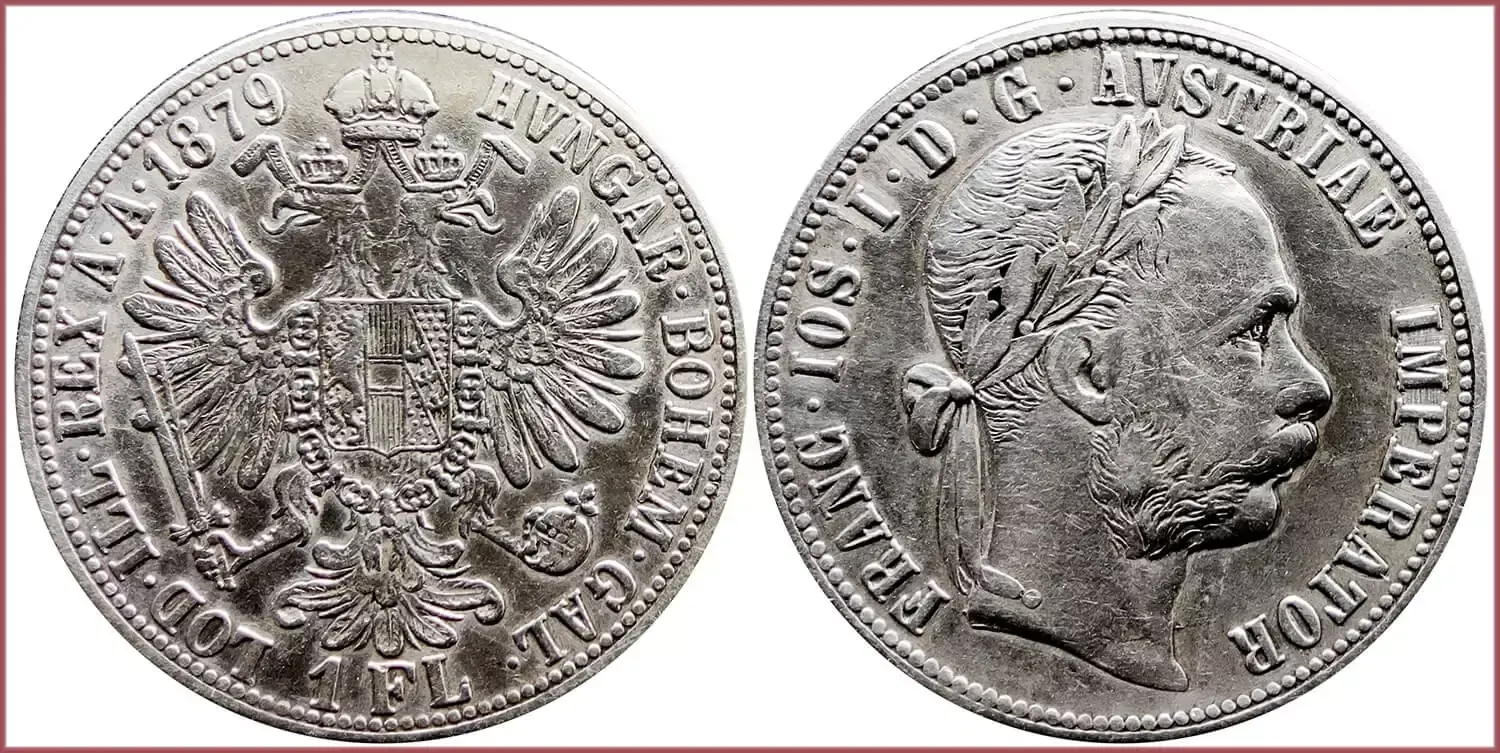FLORIN: COIN OF AUSTRIA
1 florin, 1879: Austro-Hungarian Empire
Austro-Hungarian Empire or Austria-Hungary — constitutional monarchy and great state in Central Europe during 1867-1918 (was formed with the Austro-Hungarian Compromise).
Ruler: Franz Joseph I — Emperor of Austria, King of Hungary, and the other states of the Habsburg monarchy from 1848 until 1916. Starting from 1867, he was the ruler of the newly formed Austro-Hungarian Empire.
FRANC IOS I D G AVSTRIAE IMPERATOR HUNGAR BOHEM GAL LOD ILL REX A A (full obverse and reverse legend of the coin — Fransciscus Iosephus I Dei Gratia Austriae Imperator, Hungariae, Bohemiae, Galiciae, Lodomeriae, Illyriae Rex, Archidux Austriae): Franz Joseph I, by the grace of God, Austrian Emperor, King of Hungary, Bohemia, Galicia and Lodomeria, Illyria, Archduke of Austria.
1 FL: 1 florin.
Small coat of arms of Austria as part of the Austro-Hungarian Empire: imperial eagle with a small shield (heraldic symbols of individual regions).
Laureate portrait of Franz Joseph.
The legend on the edge of the coin: VIRIBUS UNITIS ("With United Forces" — the personal motto of Emperor Franz Joseph I).
Münze Österreich (Vienna, Austria).
Mintage: 37.485.342.
- Silver (0.900): 29 mm - 12.32 g
- Reference price: 25$
COIN FLORIN — WHERE & WHEN (coins catalog: by names & emitents)
- AUSTRIA — AUSTRIAN EMPIRE + AUSTRO-HUNGARIAN EMPIRE (1857-1892): florin (but officially: gulden) = 60 kreutzer (kreuzer)
- ITALIAN, SPANISH, FRENCH, BELGIAN, DUTCH STATES and LUXEMBOURG (13th-18th centuries): florin
- COMMONWEALTH OF NATIONS (UNITED KINGDOM, AUSTRALIA, FIJI, MALAWI, NEW ZEALAND, SOUTH AFRICA — 19th-20th centuries): florin = 2 shilling = 1/10 pound
- COUNTRY OF ARUBA (1986-...): florin = 100 cent
FLORIN as coin name.
Florin — historical gold coin of high quality, which was first put into circulation in the middle of the 13th century by Florence (today — a city in Italy, the administrative center of the Tuscany region). It can be considered one of the cult coins of all times and peoples, which significantly influenced world numismatics.
Wikipedia points out an interesting fact about the appearance of this coin: "The arrival of African gold via trans-Saharan caravan routes to the Maghreb, and then to Western Europe, allowed the medieval Italian republics of Genoa, Florence, and later Venice to start minting their own gold coins. In 1252 the minting of the gold genovino in Genoa and the gold florin in Florence began. Both the genovino and the florin were minted from almost pure gold".
Almost immediately, the coin became widespread in Europe, and soon various states began minting gold coins similar to florin.
In different countries, extremely widespread coins of the florin type received local names: ducat or sequin (originally — state entities on the territory of modern Italy), gulden (Germany and the Netherlands: from "guldin pfenninc" — "gold pfennig"), forint (Hungary).
As early as the Middle Ages, gold coins of the florin type were minted on German lands, which were gradually given the local name — gulden. Interestingly, the Austrian Empire practiced issuing guldens with the legend "fl" ("florin").
To date, the florin has remained in monetary circulation in only one country of the world — on the island of Aruba in the Caribbean Sea.
The name of the florin coin comes from the name of the place where its minting began — the city of Florence (Latin "Florentia"). By the way, the coat of arms of this city depicts a flower (Latin "Flos") of a lily, which was the main subject of the first florins.











